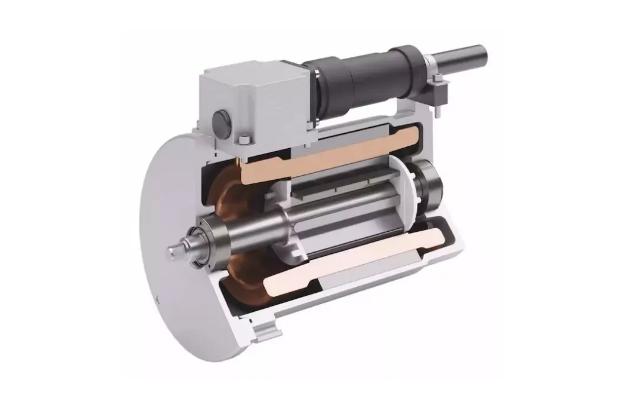Advanced system design and parts manufacturing efficient and energy-saving motor
Motor provides more than 60% of industrial power, efficiency is a key design parameter, and the efficiency of motor design is more important than ever. Efficiency is defined as the ratio of the mechanical power delivered to the power provided. A motor with an efficiency of 85% converts 85% of electric energy into mechanical energy, and the remaining 15% is used as heat dissipation.
The energy-saving motor adopts high-quality materials and optimized design to achieve higher efficiency. For example, the higher the aluminum content in the rotor, the higher the slot filling coefficient in the stator and the smaller the resistance loss. Optimized rotor structure and rotor stator air gap reduce stray load loss. The improved design of cooling fan makes the loss of wind resistance of motor cooling minimum. The rotor and stator core adopt higher quality and thinner steel laminations,
which can greatly reduce the magnetization loss. Finally, the reduction of friction loss is caused by higher quality bearings. The following figure shows the explosion diagram of AC induction motor, Indicating the shell and bearing components.
- Optimization of rotor / stator lamination size and quality of steel used
1.1 hysteresis loss and eddy current loss are called core loss together. About 20% of the total loss is caused by eddy current and core saturation. The eddy current generated in the lamination moves relative to the changing magnetic field, which will cause significant power loss. Laminated stator cores reduce eddy current losses, which can be minimized by more laminations based on iron mass, resistivity, density, thickness, frequency, and flux density.
1.2 the hysteresis loss is produced when the flux of the magnetic circuit changes constantly. Most of the load materials used in the motor are steel used for the stator and rotor cores. By reducing the lamination thickness, the flux density and core loss are minimized. The better grade lamination steel can be selected by annealing to change the grain structure for magnetization and reduce the hysteresis loss. The eddy current loss is reduced by increasing the resistivity of the steel containing silicon, but the silicon content increases the die wear during stamping because it increases the hardness of the steel. The damaged steel crystal in the stamping process seriously reduces the magnetic quality of the affected volume. Annealing flattens the lamination and recrystallizes the damaged crystals during stamping, thus extending a sheet thickness into the lamination.
- Stator lamination by immersion process
Impregnated stator strengthens the electrical insulation of stator winding, prevents the influence of chemicals or harsh environment, and enhances heat dissipation. Thermosetting plastics including epoxy resin, phenolic resin and polyester are used to impregnate the stator. The bath method is to immerse the stator in the resin for a long time to ensure the best penetration and protection. Another method of impregnation, called vacuum pressure, uses a tank that is first emptied and then pressurized to achieve penetration of the stator. Finally, the cavitation is extracted from the electric winding, which improves the thermal conductivity of the winding.
The advantages of multiple slots are to reduce leakage reactance, reduce tooth pulsation loss and improve overload capacity. The disadvantages of more stator slots are increased cost, weight, magnetization current, iron loss, poor cooling, temperature rise and efficiency reduction.
3.High quality pure aluminum for rotor die casting
The customized rotor can maximize the starting torque, reduce the conductor resistance and improve the efficiency. Most induction motor rotors are squirrel cage design. They are durable, simple in structure and low in price, but they have low starting torque. Copper rotor improves efficiency, but it is difficult and expensive to manufacture.
4.the air gap between the rotor and the stator is optimized
Air gap is the radial distance between the rotor and the stator of the standard radial motor. In order to improve the design efficiency, it is necessary to maintain the optimal air gap. The air gap size relates to the design of stator, rotor, motor housing and bearing. All of these will affect the accurate alignment of the stator and rotor shaft.
5. enameled wire
A magnet or enameled wire is an electrolytic refined copper or aluminum wire that has been fully annealed and coated with one or more layers of insulation. For example, use wires with a total of 12 layers of insulation. Typical insulating films, with the increase of temperature range, are polyethylene, polyurethane, polyester and polyimide, with the maximum temperature of 250 ° C. Thicker rectangular or square magnet wires are wrapped with high temperature polyimide or glass fiber tape, more copper is used, larger conductor bars and conductors increase the cross-sectional area of stator and rotor windings. This reduces the resistance of the winding and the loss caused by the current. The copper in the stator winding of the efficient motor is usually 20% more.
7.0summary
The motor is composed of many parts, each part provides different structure and functional attributes, which results in different functions in the motor system. The function of each part ultimately affects the input performance of the motor. By optimizing the performance of each part of the motor, the performance of the motor is optimized finally.
Key words: servo motor | AC servo motor | Hxdwh motor | Hxdwh servo motor | energy saving motor | ac servo motor material |ac servo motor stator | ac servo motor rotor | ac servo motor structure|servo motor material |servo motor stator | servo motor rotor | servo motor structure|
Post time: Mar-04-2020
